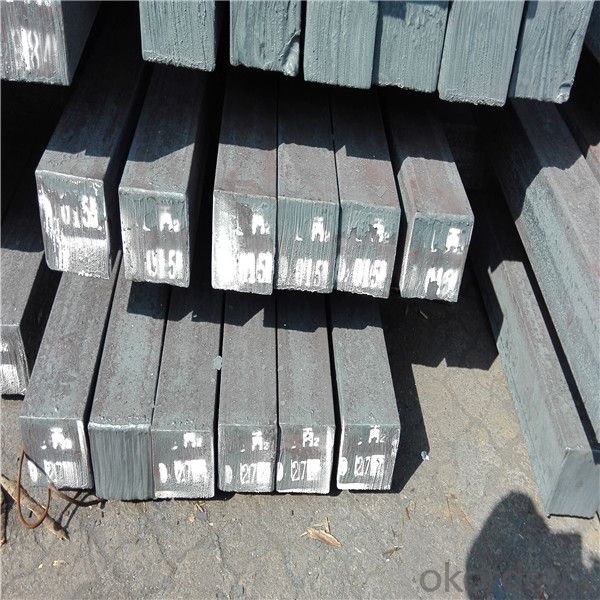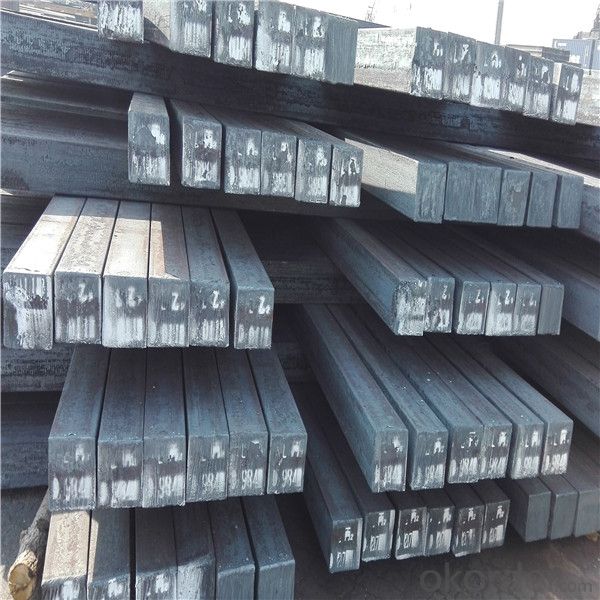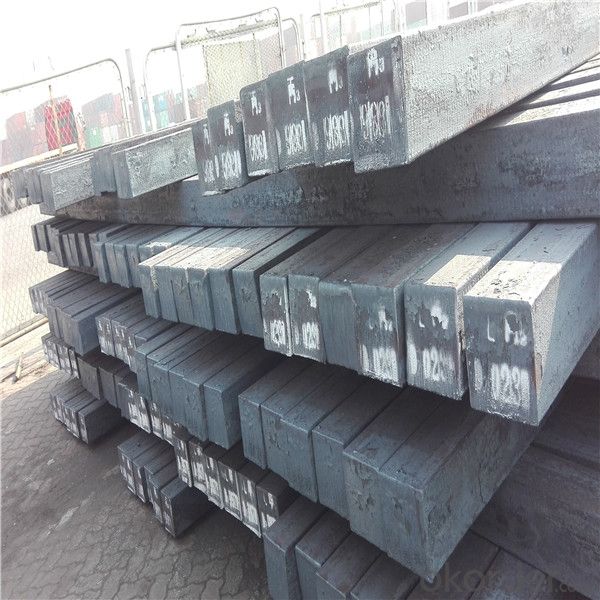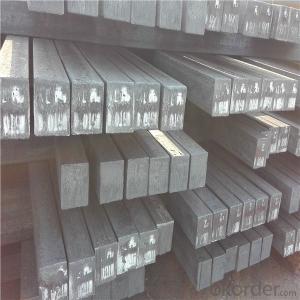Square steel billet size from 120mm to 150 mm
- Loading Port:
- Guangzhou
- Payment Terms:
- TT OR LC
- Min Order Qty:
- 1000 m.t.
- Supply Capability:
- 29814 m.t./month
OKorder Service Pledge
OKorder Financial Service
You Might Also Like
Item specifice
Steel billet
Steel billets have distinct characteristics as compared with already furnished steel bars and products. Billets
have a specific grain structure, which enables the metal to be processed more intricately. Steel billets are also
known for their malleability and ductility, especially when exposed to varying temperatures during shaping and molding.
Used for the plant, the bridge,shipment building high-rise building construction,lifting and transportation machinery, equipment manufracturing base building
the support foundation pile manufacturing.
Gade:
Standard | C(%) | Mn(%) | S(%) | P(%) | Si(%) |
Q195 | ≤0.12 | ≤0.50 | ≤0.040 | ≤0.035 | ≤0.30 |
Q235 | ≤0.20 | ≤1.40 | ≤0.045 | ≤0.045 | ≤0.35 |
Q275 | ≤0.22 | ≤1.50 | ≤0.045 | ≤0.045 | ≤0.35 |
20MnSi | 0.17-0.25 | 1.2-1.6 | ≤ 0.050 | ≤ 0.050 | 0.40-0.80 |
3SP | 0.14-0.22 | 0.40-0.85 | ≤ 0.050 | ≤ 0.040 | 0.05-0.15 |
5SP | 0.28-0.37 | 0.50-1.00 | ≤ 0.050 | ≤ 0.040 | 0.15-0.30 |



Our service :
We have a plant and professional team to provide our best service, from the start of production until the
loading into the vessel, we have a complete quality follow up procedure, to assure our products arrives to the customer with satisfaction. Welcome new and old customers
to contact us for future business relationships! We will give you a surpise price.
Packing :
Within 30 days
1.Standard export package
2.In bundles with steel strips
3.As the requirements of the customers
FAQ:
Q: What is payment terms?
A: FOB 30% T/T IN ADVANCE AS DEPOSIT AND 70% T/T BEFORE SHIPMENT
CIF and CFR 30% T/T IN ADVANCE AS DEPOSIT AND 70% T/T AS THE COPY OF B/L OR L/C AT SIGHT
Q:How to guarantee the quality of the products?
A:We have established the international advanced quality management system,every link from raw material
to final product we have strict quality test;We resolutely put an end to unqualified products flowing into the market.
At the same time, we will provide necessary follow-up service assurance.
Q:How long can we receive the product after purchase?
A :In the purchase of product within three working days, We will arrange the factory delivery as soon as possible.
The pecific time of receiving is related to the state and position of customers.
- Q:What are the main factors affecting the ductility of steel billets?
- The ductility of steel billets is affected by several primary factors. First and foremost, the carbon content in the steel plays a pivotal role. Higher levels of carbon generally decrease ductility and make the steel more brittle. This is due to the tendency of carbon atoms to form strong bonds with iron atoms, resulting in a material that is harder and less malleable. The composition of other alloying elements in the steel also has an impact on ductility. Depending on their concentration, elements like manganese, silicon, and phosphorus can have varying effects on the steel's ductility. For instance, manganese can enhance ductility while phosphorus can reduce it. The heat treatment process is another crucial factor that significantly affects the ductility of steel billets. Rapid cooling, known as quenching, can enhance the strength of the steel but may simultaneously decrease its ductility. Conversely, annealing, which involves heating the steel and gradually cooling it, can improve the material's ductility. Furthermore, the presence of impurities and defects in the steel can influence its ductility. Inclusions, such as non-metallic particles, can act as stress concentrators and diminish the material's ability to deform plastically. Similarly, cracks, voids, and other defects can weaken the steel and lower its ductility. Lastly, the grain size of the steel can impact its ductility. Fine-grained steels generally exhibit higher ductility compared to coarse-grained ones. This is because smaller grain boundaries create more obstacles for dislocation movement, thereby increasing resistance to deformation. In conclusion, the ductility of steel billets is influenced by multiple factors, including carbon content, alloying elements, heat treatment, impurities and defects, and grain size. It is crucial to comprehend and control these factors to ensure the desired ductility properties of steel.
- Q:How are steel billets used in the manufacturing of valves and fittings?
- Steel billets are used in the manufacturing of valves and fittings as the starting material. These billets are heated and then mechanically or forge pressed to shape them into the desired valve or fitting component. The billets provide the necessary strength and durability required for these critical components in various industries.
- Q:What are the different types of tests conducted on steel billets?
- There are several different types of tests that are conducted on steel billets to ensure their quality and suitability for various applications. These tests are essential in determining the mechanical properties, chemical composition, and integrity of the steel billets. 1. Chemical Composition Analysis: This test involves examining the chemical composition of the steel billets to ensure that they meet the required standards and specifications. It measures the levels of various elements such as carbon, manganese, silicon, sulfur, and phosphorus. 2. Tensile Test: This test measures the tensile strength, yield strength, and elongation of the steel billets. It helps determine the ability of the steel to withstand pulling forces without breaking. 3. Hardness Test: This test determines the hardness of the steel billets, which is essential in evaluating their resistance to wear, deformation, and penetration. Commonly used hardness tests include Brinell, Rockwell, and Vickers tests. 4. Impact Test: This test measures the toughness and ability of the steel billets to absorb energy under impact or sudden loading conditions. It helps determine their resistance to fracture and cracking. 5. Ultrasonic Testing: This non-destructive test uses high-frequency sound waves to detect internal flaws or defects in the steel billets. It is commonly used to detect cracks, voids, and inclusions that may affect the structural integrity of the billets. 6. Dimensional Inspection: This test ensures that the steel billets meet the specified dimensional requirements, including length, width, and thickness. It ensures that the billets are suitable for their intended application and can be used in subsequent manufacturing processes without any issues. 7. Macroscopic Examination: This visual inspection involves examining the surface and internal structure of the steel billets using magnification. It helps identify any visible defects such as cracks, porosity, segregation, or any other irregularities. 8. Microscopic Examination: This test involves examining the microstructure of the steel billets using a microscope. It helps determine the grain size, presence of phases, and any abnormalities in the steel structure that may affect its properties. These tests collectively ensure that the steel billets meet the required quality standards and possess the necessary mechanical properties for their intended applications. They help ensure the safety, reliability, and performance of the steel billets in various industries such as construction, automotive, aerospace, and manufacturing.
- Q:What are the main factors that determine the market price of steel billets?
- The market price of steel billets is influenced by several key factors. Firstly, the demand and supply dynamics play a significant role in determining the market price. If there is a high demand for steel billets and the supply is limited, the price tends to increase. Conversely, if the demand is low and there is an oversupply of steel billets, the price may decrease. Another important factor is the cost of raw materials. Steel billets are primarily made from iron ore, which is subject to price fluctuations in the global market. Increases in the cost of iron ore can drive up the market price of steel billets, as manufacturers pass on the higher production expenses to consumers. Energy costs also impact the market price of steel billets. Steel production is an energy-intensive process, and any fluctuations in energy prices, such as those of coal or natural gas, can influence the final price of steel billets. Additionally, global economic conditions and geopolitical factors can have a significant impact on the market price of steel billets. Economic growth or recession in major steel-consuming countries can affect demand, while trade policies, tariffs, or sanctions imposed by governments can disrupt the supply chain and result in price volatility. Furthermore, technological advancements and innovations in the steel industry can influence the market price as well. Improvements in production processes or the development of new steelmaking techniques can affect the cost of manufacturing steel billets, which can in turn impact the market price. Lastly, currency exchange rates can also affect the market price of steel billets. If the currency of steel-producing countries strengthens against the currencies of steel-consuming countries, it can make the steel billets more expensive for foreign buyers, potentially leading to a decrease in demand and a subsequent decrease in price. In summary, the market price of steel billets is determined by the interplay of supply and demand dynamics, the cost of raw materials and energy, global economic conditions, technological advancements, and currency exchange rates. Being aware of these factors is crucial for both buyers and sellers in the steel billet market to make informed decisions and adapt to changing market conditions.
- Q:What are the potential applications of steel billets in the automotive industry?
- Steel billets have a wide range of potential applications in the automotive industry due to their exceptional strength and durability. One key application is in the manufacturing of automotive components such as engine blocks, crankshafts, and transmission parts. These components require a material that can withstand high temperatures, heavy loads, and repetitive stress, which steel billets provide. Another important application is in the production of chassis and body panels. Steel billets are often used to create the structural framework of a vehicle, providing the necessary strength and rigidity to ensure safety and stability. Additionally, steel billets can be formed into various shapes and sizes, allowing for the customization of chassis components to meet the specific requirements of different vehicle models. Steel billets are also utilized in the production of suspension systems and steering mechanisms. These parts require a material that can absorb vibrations, dampen shocks, and provide precise control. Steel billets possess these properties, making them an ideal choice for these critical automotive components. Furthermore, steel billets find applications in the production of exhaust systems, as they can withstand high temperatures and corrosive environments. The ability of steel to resist rust and corrosion ensures the longevity of the exhaust system, contributing to the overall performance and efficiency of the vehicle. In summary, the potential applications of steel billets in the automotive industry are vast. From engine components to chassis parts, suspension systems to exhaust systems, steel billets provide the strength, durability, and versatility required to meet the demanding needs of the automotive sector.
- Q:What are the potential applications of steel billets in the medical sector?
- Steel billets have a wide range of potential applications in the medical sector. One of the key uses of steel billets is in the manufacturing of medical instruments and surgical tools. The high strength and durability of steel make it an ideal material for producing instruments that require precision and reliability. From scalpels and forceps to bone saws and orthopedic implants, steel billets can be transformed into various medical tools that are essential for surgeries and procedures. Additionally, steel billets can be utilized in the production of medical equipment such as hospital beds, wheelchairs, and stretchers. These products require a sturdy and robust material to ensure patient safety and comfort. Steel provides the necessary strength to support the weight of patients and withstand regular usage, making it an excellent choice for such applications. Furthermore, steel billets can be used in the construction of medical facilities and infrastructure. Steel is known for its structural integrity, making it suitable for building hospitals, clinics, and research laboratories. Steel structures offer resistance against earthquakes, fires, and other natural disasters, ensuring the safety of both medical personnel and patients. Moreover, steel billets can be employed in the manufacturing of medical storage systems and cabinets. These storage solutions are crucial for maintaining a sterile and organized environment, preventing cross-contamination, and ensuring the proper storage of medical supplies and equipment. In conclusion, steel billets have numerous potential applications in the medical sector. From the production of surgical instruments and medical equipment to the construction of medical facilities, steel's strength, durability, and reliability make it an invaluable material in enhancing patient care and safety.
- Q:What is the role of steel billets in the construction of offshore platforms?
- Steel billets play a crucial role in the construction of offshore platforms as they are the primary raw material used to fabricate various structural components such as beams, columns, and braces. These billets undergo a series of processes including heating, rolling, and shaping to form the desired structural shapes. Their high strength and durability make them ideal for withstanding the harsh marine environment and supporting the weight of the platform. Ultimately, steel billets serve as the building blocks for offshore platforms, ensuring the structural integrity and safety of these critical structures.
- Q:What are the different types of cleaning equipment used for steel billets?
- There are several different types of cleaning equipment that are commonly used for steel billets. These include: 1. Shot blasting machines: Shot blasting is a process that involves propelling small metal or mineral particles at high speed onto the surface of the steel billets. This helps to remove any rust, scale, or other contaminants, leaving the surface clean and smooth. 2. Ultrasonic cleaners: Ultrasonic cleaning involves the use of high-frequency sound waves to agitate a cleaning solution. This helps to remove dirt, oil, and other contaminants from the surface of the steel billets. Ultrasonic cleaners are particularly effective for removing stubborn or hard-to-reach contaminants. 3. Acid pickling tanks: Acid pickling is a process that involves immersing the steel billets in a tank of acidic solution. The acid helps to dissolve any rust, scale, or other contaminants on the surface of the billets. After pickling, the billets are usually rinsed and then dried. 4. Power washers: Power washers, also known as pressure washers, use a high-pressure spray of water to remove dirt, oil, and other contaminants from the surface of the steel billets. This is a particularly effective method for cleaning larger or heavier billets. 5. Mechanical cleaning brushes: Mechanical cleaning brushes, such as wire brushes or abrasive pads, are often used to manually scrub the surface of the steel billets. This helps to remove any loose dirt, rust, or scale. Mechanical cleaning brushes are typically used in conjunction with other cleaning methods. Overall, the choice of cleaning equipment for steel billets depends on factors such as the extent and type of contaminants present, the desired level of cleanliness, and the size and shape of the billets. Different combinations of these cleaning methods may be used to achieve the desired result.
- Q:What are the different surface treatments for improved formability in steel billets?
- To enhance the formability of steel billets, various surface treatments can be employed. These treatments aim to increase the steel's ability to be shaped and formed without experiencing cracks or fractures. One effective method for enhancing formability is the utilization of lubricants or coatings. These substances aid in reducing friction between the steel and the forming tools, facilitating the shaping of the billets without causing any damage. Lubricants can be administered in the form of oils, greases, or solid films, and they can be utilized in both hot and cold forming procedures. Another technique for improving formability is shot peening, which entails bombarding the steel's surface with small steel or ceramic particles that possess high velocity. This process creates a compressive stress layer on the surface, effectively preventing crack initiation and propagation during the forming process. Additionally, shot peening can enhance the steel's fatigue resistance. In certain instances, heat treatment can be employed to enhance formability. This involves heating the steel to a specific temperature and rapidly cooling it. This process, known as quenching and tempering, can modify the steel's microstructure, increasing its ductility and making it easier to shape. Heat treatment also aids in relieving residual stresses in the steel, thereby improving formability. Lastly, surface coatings can be applied to steel billets to enhance formability. These coatings act as a protective barrier between the steel and the forming tools, reducing friction and preventing wear. Various methods, such as electroplating, thermal spraying, or chemical vapor deposition, can be utilized to apply these coatings. In conclusion, there exist several surface treatments that can be employed to enhance formability in steel billets. These treatments encompass the application of lubricants or coatings, shot peening, heat treatment, and surface coatings. Each treatment offers unique advantages and can be utilized based on the specific requirements of the forming process.
- Q:Can steel billets be used for making sculptures?
- Yes, steel billets can be used for making sculptures. Steel is a versatile material that offers various benefits for sculpting. Its strength and durability make it suitable for creating large-scale sculptures that can withstand outdoor conditions. Steel billets can be easily manipulated and shaped into different forms, allowing artists to explore their creativity and bring their ideas to life. Additionally, steel can be welded, polished, and painted, providing further opportunities for customization and artistic expression. Overall, steel billets offer sculptors a robust and versatile medium to create unique and lasting sculptures.
1. Manufacturer Overview |
|
|---|---|
| Location | |
| Year Established | |
| Annual Output Value | |
| Main Markets | |
| Company Certifications | |
2. Manufacturer Certificates |
|
|---|---|
| a) Certification Name | |
| Range | |
| Reference | |
| Validity Period | |
3. Manufacturer Capability |
|
|---|---|
| a)Trade Capacity | |
| Nearest Port | |
| Export Percentage | |
| No.of Employees in Trade Department | |
| Language Spoken: | |
| b)Factory Information | |
| Factory Size: | |
| No. of Production Lines | |
| Contract Manufacturing | |
| Product Price Range | |
Send your message to us
Square steel billet size from 120mm to 150 mm
- Loading Port:
- Guangzhou
- Payment Terms:
- TT OR LC
- Min Order Qty:
- 1000 m.t.
- Supply Capability:
- 29814 m.t./month
OKorder Service Pledge
OKorder Financial Service
Similar products
New products
Hot products
Related keywords





























